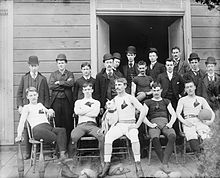History of American Football
The history of American football can be traced back to early versions of rugby. Both sports have their origins in varieties of football played in England in the mid-19th century.

American football is the result of successive divergences from rugby, most notably the rule changes made by Walter Camp, considered the "Father of American Football". Among the main changes are the introduction of the line of scrimmage and down rules. In the late 19th and early 20th centuries, the evolution of the game by college coaches such as Eddie Cochems, Amos Alonzo Stagg, Knute Rockne, and Glenn "Pop" Warner helped take advantage of the newly introduced " forward pass ". The popularity of college soccer grew and it became the dominant version of the sport in the United States in the first half of the 20th century.
The origins of professional American football date back to 1892, with the $500 contract signed by William "Ponch" Heffelfinger to play a game for the Allegheny Athletic Association against the Pittsburgh Athletic Club. In 1920, the American Professional Football Association was formed. This championship changed its name to the National Football League (NFL) two years later, and ended up becoming the main American football league in the world. A rival league to the NFL, the National Football League (NFL), began in 1960, but the pressure it put on the senior league led to a merger between the two leagues and the creation of the Super Bowl, which has become the most watched annual television event in the United States.
First games
changeAlthough there are references claiming that Native Americans were already playing a ball game, modern American football has its origins in Europe. Traditional recreational activities in villages and schools on the old continent were already practised many centuries before America was colonised by Europeans.
The first games resembled the traditional ‘mob football’, a variety of football played in medieval England, especially on Shrove Tuesday. The matches remained largely unorganised until the 19th century, when intramural football games began to take place on university campuses. Each institution developed its own variety of football. Princeton students played a sport called ‘ballown’ in 1820. A Harvard tradition known as ‘Bloody Monday’ began in 1827, consisting of a collective ball game between the freshmen and sophomore classes. Dartmouth had its own version, called ‘Old division football’, whose rules were first published in 1871, although the game dates back to the 1830s. All these games, and others, shared some similarities. They remained largely ‘crowd’ style games, with a large number of players trying to advance the ball into a goal area, often by any means necessary.
Other sources
change- Bennett, Tom. The Pro Style: The Complete Guide to Understanding National Football League Strategy. National Football League Properties, Inc., Creative Services Division.
- Bernstein, Mark F. (2001). Football: The Ivy League Origins of an American Obsession. University of Pennsylvania Press. ISBN 0-8122-3627-0.
- Gardner, Paul. The Simplest Game: The Intelligent Fan's Guide to the World of Soccer. Macmillan General Reference. ISBN 0-02-043225-9.
- Greenberg, Murray (2008). Passing Game: Benny Friedman and the Transformation of Football. PublicAffairs. ISBN 978-1-58648-477-4.
- MacCambridge, Michael (Ed.) (1999). ESPN SportsCentury. Hyperion Books. ISBN 0-7868-6471-0.
- McDonough, Will (1994). 75 Seasons: The Complete Story of the National Football League. Turner Publishing, Inc. ISBN 1-57036-056-1.
- Migdol, Gary (1997). Stanford: Home of Champions. Sports Publishing LLC. ISBN 1-57167-116-1.
- Miller, Jeffrey J. Pop Warner: A Life on the Gridiron. McFarland & Company. ISBN 978-1-4766-2274-3.
- Nelson, David M. (1994). The Anatomy of A Game. University of Delaware Press. ISBN 0-87413-455-2.
- Peretz, Howard (1999). It Ain't Over 'Til The Fat Lady Sings: The 100 Greatest Sports Finishes of All Time. Barnes and Noble Books. ISBN 0-7607-1707-9.
- Perkins, Brett (2009). Frantic Francis: How One Coach's Madness Changed Football. University of Nebraska Press. ISBN 978-0-8032-1894-9.
- Pettegrew, John. Brutes in Suits: Male Sensibility in America, 1890–1920. Johns Hopkins University Press. ISBN 978-0-8018-8603-4.
- Schmidt, Raymond (2007). Shaping College Football: The Transformation of an American Sport, 1919–1930. Syracuse University Press. ISBN 978-0-8156-0886-8.
- Umphlett, Wiley Lee (1992). Creating the Big Game: John Heisman and the Invention of American Football. Greenwood Publishing Group. ISBN 0-313-28404-0.
- Vancil, Mark (Ed.) (2000). ABC Sports College Football All-Time All-America Team. Hyperion Books. ISBN 0-7868-6710-8.
- Wagg, Stephen (Ed). Myths and Milestones in the History of Sport. Springer Publishing. ISBN 978-1-349-31693-9.
Bibliography
change- Bennett, Tom. The Pro Style: The Complete Guide to Understanding National Football League Strategy. National Football League Properties, Inc., Creative Services Division.
- Gardner, Paul. The Simplest Game: The Intelligent Fan's Guide to the World of Soccer. Macmillan General Reference. ISBN 0020432259.
- MacCambridge, Michael (Ed.) (1999). ESPN SportsCentury. Hyperion Books. ISBN 0-7868-6471-0.
- Nelson, David M. (1994). The Anatomy of A Game. University of Delaware Press. ISBN 0-87413-455-2.
- Peretz, Howard (1999). It Ain't Over 'Til The Fat Lady Sings: The 100 Greatest Sports Finishes of All Time. Barnes and Noble Books. ISBN 0-76071-7079.
- Vancil, Mark (Ed.) (2000). ABC Sports College Football All-Time All-America Team. Hyperion Books. ISBN 0-7868-6710-8.